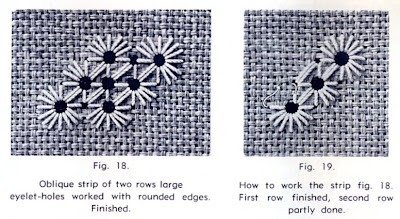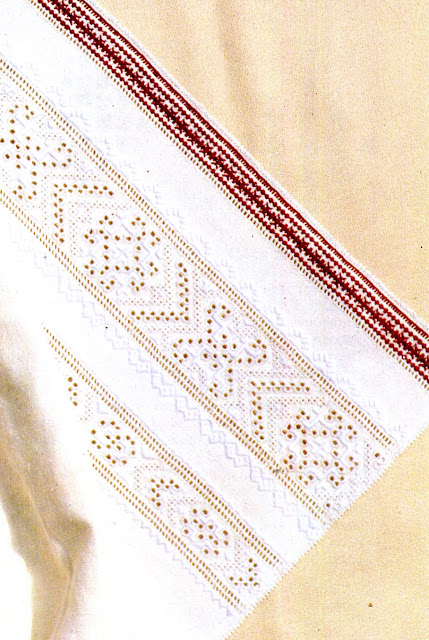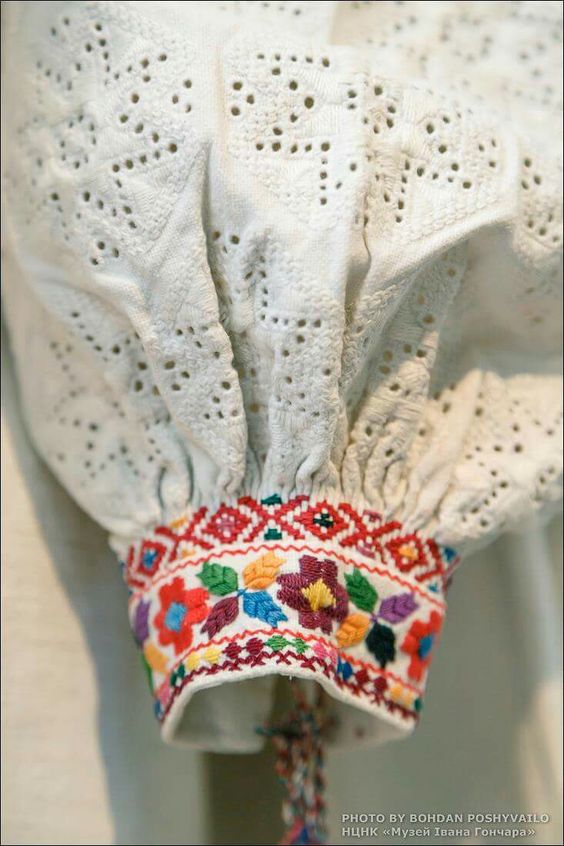Hello all,
Today i will talk about a new region, Pokuttia. Pokuttia as a cultural region is in eastern Ivano-Frankiwsk Oblast, North of the Hutsul region in the Carpathians, and south of the Dnister which forms the southern border of the Podillia region. On the east it borders on Bukovyna. On the west the border is unclear, with some people considering it to be between the towns of Kolomyja and Nadvirna, others consideri it to extend to the Boiko lands along the ridge which runs south and a bit west from the city of Ivano-Frankiwsk. Pokuttia means literally 'the land in the corner' or angle, referring to the confluence of the Prut and the Cheremosh, and that this is the eastern 'corner' of Halychyna.
Here is a map showing the more extensive definition of Pokuttia.
The costume of Pokuttia is very similar to that of both Podillia and Bukovyna in general terms. This is the region of the second type of Ukrainian costume, with a wrap-around skirt known as obhortka. The distinction is in details, especially in the embroidery.
Whitework embroidery is widespread in Ukraine and the rest of Europe. Many Ukrainians think that all white-on-white Ukrainian embroidery is from the Poltava region. But it is found in many places, and there are two notable centers besides Poltava. One is Vinnytsia in Eastern Podillia, and the other is around Sniatyn.
Whitework embroidery is widespread in Ukraine and the rest of Europe. Many Ukrainians think that all white-on-white Ukrainian embroidery is from the Poltava region. But it is found in many places, and there are two notable centers besides Poltava. One is Vinnytsia in Eastern Podillia, and the other is around Sniatyn.
The Sniatyn district is found in the southeast corner of Ivano-Frankiwsk oblast, and the southeast corner of Pokuttia. The town of Sniatyn is indicated with a red dot in the southeast corner of the map above. Here is the Sniatyn district within Ivano-Frankiwsk Oblast.
The image at the head of the article is of Maria Ursuliak, wearing a typical Pokuttia costume with 'white shoulders'.
This type of embroidery always includes a variety of stitches, verkhoplut, counted satin stitch, faggot stitching and various types of hemstitch are the most common. The most distinctive element are drawn-stitch eyelets, known in Ukrainian as 'Nightingale eyes'. The nightingale is the national bird of Ukraine. There is an old folk saying that nightingales know our language, as Ukrainians consider their language to be especially lyrical and melodic.
This region is unique in that designs are often based on groups of eyelets, and other elements finish the design around it.
This type of embroidery always includes a variety of stitches, verkhoplut, counted satin stitch, faggot stitching and various types of hemstitch are the most common. The most distinctive element are drawn-stitch eyelets, known in Ukrainian as 'Nightingale eyes'. The nightingale is the national bird of Ukraine. There is an old folk saying that nightingales know our language, as Ukrainians consider their language to be especially lyrical and melodic.
This region is unique in that designs are often based on groups of eyelets, and other elements finish the design around it.
Here is another example of a woman's shirt from the village of Vydyniw, just outside Sniatyn.
Another example.
Here is one example which also includes chain stitch.
DMC featured this type of embroidery in their book 'Openwork Embroidery'. They have people copy very clean versions of the original designs, and illustrate their books with these copies. They tend to be less dense than village embroidery. Here is their copy of this same design.
They give very detailed instructions on how to execute both the diagonal groups and the spot group designs. The diagonal groups are executed one side at a time.
Often the design includes more than one row of eyelets.
The eyelets may be round, as shown above, but are also made with square corners. Another version is to use blanket stitch. Here is a design which uses both of those variants.
The eyelets may define the main element of the design.
When executing small groups of spot designs, individual stitches help to form more than one eyelet.
You will notice various types of hemstitching in the above images. Directions for all of these are also found in this book, which sadly, is out of print, but may be found at used bookstore sites.
One thing i should mention. This book includes images of designs from all over eastern Europe. The Ukrainian designs are shown on plates 1 [Vinnytsia],12 and 13 [Sniatyn]. There is a typographical error which states that plate 7 is also Ukrainian, Plate 7 is in fact Slovak, and is also listed as such. As a result of this typo, plate 7 has been reproduced in at least one Ukrainian book. This is an example of how errors perpetuate themselves.
Some more images of the designs in this book from the Sniatyn region.
Here is a photo of a woman's chemise done in this style from Sniatyn.
You will notice that the sleeves on this chemise follow the three part canon of embroidery which is common also in Podillia, Bukovyna and also Moldavia and other parts of Romania.
See my article on this subject.
http://folkcostume.blogspot.com/2011/01/sleeve-embroidery-podillia-moldavia.html
Here are a couple examples of the embroidery from the lower part of the sleeves. In the second image the top of the sleeve is towards the left.
A chemise which is a masterpiece of this type of work is illustrated in Tania Diakiw O'Neill's book 'Ukrainian Embroidery Techniques', pages 82 -85. This remains the best book on the subject in English, and I heartily recommend it to anyone who wishes to learn more about Ukrainian Embroidery. Unfortunately, it also is out of print. I hope that she will be able to put out a second edition.
A third book which gives instructions on this type of embroidery is 'Ukrainian Whitework' by Gay Eaton. This book is still in print and I also recommend it. She gives very good detailed instructions. She also provides quite a few designs which she invented using the traditional elements of this embroidery, as Ukrainian embroiderers have always done. I personally think that some of the designs have too much plain cloth in between the elements, but that is a matter of taste. You will see echoes of the designs which I have included in this posting. She also includes designs from both the Vinnytsia and Poltava traditions. Here is a sampler showing some of her designs.
Many of the chemises from this region do not have embroidery on the lower sleeves.
Many also use a variation of this technique which uses larger eyelets. These are made by cutting one intersection of the ground threads and proceeding as for the above designs.
These large eyelets, sometimes called dowbane, may be grouped horizontally and vertically as well as diagonally. Whitework designs in Ukraine may use threads of different shades. Some threads may be unbleached, or coated with ash, which gives a grayer tone, and some may be rubbed with beeswax or other substance to give a yellower tone. Here is a woman's chemise from the village of Rusiv near Sniatyn.
Here is a modern copy of one of the sleeve designs using only one shade of white.
Otherwise, these large eyelets participate in the composition much as the smaller eyelets do.
Here are several examples.
Some of these are taken from old publications and the quality may not be that good, I apologize.
Here is another chemise from the Sniatyn region, with a second design.
As you can see, the whitework is sometimes combined with other colors. In this case the shoulder inset is framed with polychrome embroidery which is also used in Pokuttia.
Here is a photograph of a man's shirt. This photo was taken by a woman who calls herself 'Mawka Lisova', which is a traditional Ukrainian Forest nymph. She has graciously given me permission to use her photographs.
And a couple more photos of women's chemises by Mawka.
You can see the traditional woven overskirt and sash on the left of these next two images.
You can see more of her photographs here.
https://plus.google.com/photos/115068169732517408090/albums?banner=pwa
Here is a photograph of the costume in Tulukiw village, Sniatyn district, Pokuttia. You will note that polychrome embroidery is also done in this region. Tunic shaped, knee length shirt for the men, narrow linen trousers, boots, shoes, or moccasins, and wide sash or belt. The girl is wearing a wedding wreath.
The women wear a long chemise, heavy wrap-around overskirt called obhortka and a wide sash.
Here is a somewhat out of scale drawing of the basic Pokuttia costume. This drawing shows a married woman with a peremitka wrapped around her head and neck.
The overskirt may be left down, or one or both corners may be tucked up into the sash. A narrow apron may be worn with it as well. Where the obhortka in Podillia is basically black, in Pokuttia the main color tends to be a brick or rust red. We can see in this drawing that the ustawka embroidery is white with a colored frame.
Sheepskin vests somewhat similar to those worn by the Hutsuls may also be worn.
The ornament on these vests is unique to the Sniatyn area, consisting of small straight teeth and red pompoms. This first is a man's costume with exceptionally wide embroidery on the shirt.
Here are two sketches made by Kul'chytska when she visited the Sniatyn area, the first of the embroidery, I think that what she drew as small eyelets is actually faggot stitching. The second is a woman in costume.
This woman is from the village of Orolets'.
In general, the costume is very similar to that worn in the Horodenka district which lies just to the north.
A woman's shirt from the village of Rusiw.
Some more images of this kind of work
A woman from Sniatyn area, notice the gerdan worn on the head.
An old photograph of a family from Torhovytsia. The mother has white shoulder embroidery with a colorful frame, but the daughter is wearing red embroidery, likely curly stitch. The boys either have white embroidery or none.
Here is a woman in full costume from the village of Toporiwtsi, also in Horoden'ka district.
This is Maria Tofan from the village of Rusiw in Sniatyn district.

Thank you for reading, I hope that you have found this interesting and inspiring. I encourage you to do a project using this type of embroidery. Enrich your surroundings with a bit of the white embroidery of Sniatyn.
email
Source Material:
Iryna Svyontek, 'Pokutski Vyshywky Prykarpattia', L'viw, 2013
DMC library, 'Openwork Embroidery' France, 1970
Tania Diakiw O'Neill, 'Ukrainian Embroidery Techniques', Mountaintop, Pa, 1984
Gay Eaton, 'Ukrainian Whitework', Dunedin, New Zealand, 2005
Olena Kulynych-Stakhurska, 'The Art of Ukrainian Embroidery', L'viw, 1996
Tamara NIkolajewna, 'Ukrainian Costume, Hope for a Renaissance, Kyjiw [Kiev], 2005
K. I. Matejko, 'Ukrajinskyj Narodnyj Odjah', Kyjiw [Kiev], 1977
Tamara Nikolajewna, 'Istoria Ukrajins'koho Kostiuma', Kyjiw [Kiev], 1996
Oksana Grabowicz et al, 'Traditional Designs in Ukrainian Textiles', The Ukrainian Musem, New York, 1977
M. C. Bilan and H. H. Stel'mashchuk, 'Ukrajins'kyj Strij', L'viw, 2000
Lubow Wolynetz, 'Ukrainian Folk Art', The Ukrainian Museum, New York, 1984
Feel free to contact me with requests for research.
Source Material:
Iryna Svyontek, 'Pokutski Vyshywky Prykarpattia', L'viw, 2013
DMC library, 'Openwork Embroidery' France, 1970
Tania Diakiw O'Neill, 'Ukrainian Embroidery Techniques', Mountaintop, Pa, 1984
Gay Eaton, 'Ukrainian Whitework', Dunedin, New Zealand, 2005
Olena Kulynych-Stakhurska, 'The Art of Ukrainian Embroidery', L'viw, 1996
Tamara NIkolajewna, 'Ukrainian Costume, Hope for a Renaissance, Kyjiw [Kiev], 2005
K. I. Matejko, 'Ukrajinskyj Narodnyj Odjah', Kyjiw [Kiev], 1977
Tamara Nikolajewna, 'Istoria Ukrajins'koho Kostiuma', Kyjiw [Kiev], 1996
Oksana Grabowicz et al, 'Traditional Designs in Ukrainian Textiles', The Ukrainian Musem, New York, 1977
M. C. Bilan and H. H. Stel'mashchuk, 'Ukrajins'kyj Strij', L'viw, 2000
Lubow Wolynetz, 'Ukrainian Folk Art', The Ukrainian Museum, New York, 1984











































































Great!! Thank you for al the information and images.
ReplyDeleteДякую! Гарно підібрана, багата і цінна інформація.
ReplyDeleteНайкращі побажання
Ja duzhe rado shcho vy nym tsikavujetes' Nam treba pidtrymaty nashi tradytsijni vyshywkky. I shchyri pobazhznniam i vam.
DeleteI'd never noticed that typo in the DMC book (I actually dug out my copy to check!). They obviously meant Plate XII not VII. How fascinating to compare a 'genuine' embroidery to its DMC model - I've always wondered about the difference - the models are so fine and square and perfect.
ReplyDeleteRegarding the Kul'chytska sketch, at first glance I thought that the rows of small circles alongside the bigger eyelets were spangles...
Thanks for the wonderful post.
thank you for your encouragement, Nays.
ReplyDeleteThe main point of the DMC models was to show the stitching clearly, and they went to great lengths to do that.
I am glad that you enjoy these postings, and I hope that you do some of this embroidery
This comment has been removed by the author.
ReplyDeleteThanks a lot for the great explanation.
ReplyDeleteThis comment has been removed by the author.
ReplyDeleteAwesome job on presenting each region in such detail!! Love the variety of sources and the stitch illustrations. Looking forward to the next region.
ReplyDeleteGreat work. Love this whitework embroidery. Thanks a lot.
ReplyDeletevery nice work thanks.
ReplyDeleteGreat!
ReplyDelete